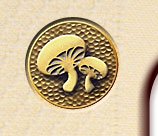

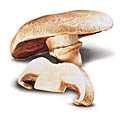
Portabella mushrooms are the largest of the commercially available mushrooms and have a rich, robust mushroom taste and a texture that has been compared to fine beef filet mignon.
MORE INFORMATION

Criminis are tan to brown in color with a firm, buttery texture and a flavor similar to white button mushrooms but more intense. They are picked while they are still closed, with their veil covering the gill surface.
MORE INFORMATION
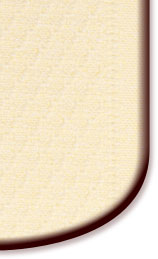
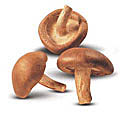
The Shiitake has a classic mushroom shape with open white gills. It has a meaty and earthy smoky taste and its texture is firm and slightly chewy.
MORE INFORMATION

Oyster mushrooms comprise a long list of different species and are available in an amazing array of colors and sizes. They have a texture much like their seafood namesake, with a mild taste and pleasant odor.
MORE INFORMATION
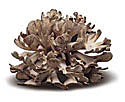
Some other common names for Maitake are Sheep's Head and Hen-of-the-Woods. Maitake mushrooms form a brown to gray cluster of petals or fronds on a fused, central stalk.
MORE INFORMATION

One of the most popular edible mushrooms in Japan, Beech mushrooms are crisp, firm-fleshed mushrooms with short, thick stems. They have marbled caps with an attractive watermark pattern and are available in brown or white varieties.
MORE INFORMATION
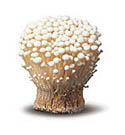
Enoki are tender, white mushrooms with long stems and small caps and a sweet, mild taste. They are usually sold in clusters just as they are pulled from the bottles they are traditionally grown in.
MORE INFORMATION

Light brown trumpet-shaped caps resting on tender white stems. This delicately flavored mushroom is also known as the King Oyster.
MORE INFORMATION

The pom pom mushroom is a delicate white sphere with soft spines and no stem. It has a mild, sweet taste and pleasant texture that have been compared to lobster or very tender veal.
MORE INFORMATION
Botanical Name: Lepista nuda
Frilly, pale blue, gilled cap. Available year-round.
Serving Suggestions: Great to sauté and prepare with fish. Adds texture to polenta and egg dishes.
Chanterelle
Botanical Name: Cantharellus cibarius
Golden, with white flesh. Button or vase shaped cap with veins. Apricot nuances. Available year-round except May-June.
Substitute hedgehogs.
Serving Suggestions: Slow roast with game, ham, beef. Sauté with cream for pasta sauce.
Yellowfoot
Botanical Name: Cantharellus tuberformis
Vase-shaped with bright yellow stem, beige to golden cap. Woodsy flavor. Available January-February. Substitute chanterelles or hedgehogs.
Serving Suggestions: Saute with black trumpets as garnish for game, roasts, and chops; mushroom tartlettes and crostini.
Black Trumpet
Botanical Name: Craterellus cornucopioides
Light gray to jet-black, vase shape, highly perfumed. Available year-round, except April-May.
Serving Suggestions: Sauté for crostini, in risotto, as garnish for scallops, seafood or chicken.
Porcini/Cepe
Botanical Name: Boletus edulis
Bulbous stem and rounded cap, from ivory to reddish brown. Taste similar to winecap. Available year-round, except August.
Serving Suggestions: Grill caps, dice and sauté or roast stems. Great in soups, stews and stir-frys. Substitute shiitake or winecap.
Chicken of the Woods
Botanical Name: Laetiporus sulphureus
Fan-shape, bright yellow and orange shades, 6-12 inches across. Chicken flavor, firm texture. Available in May and September-October. Substitute bluefoot, lobster or oyster.
Serving Suggestions: Layer with potatoes, simmer in broth, grill, stew or stir-fry.
Fried Chicken Mushroom
Botanical Name: Lyophyllum decastes
Light brown, medium firm with gills. Earthy flavor. Only available in October.
Serving Suggestions: With game and chops.
Honey Mushroom
Botanical Name: Armillaria mellea
Honey-colored clusters. Available August-September. Substitute beech, mousseron, fried chicken mushroom, or shiitake.
Serving Suggestions: With spaghetti, sautéed in butter. Also soups, stews and stir-frys.
Hedgehog
Botanical Name: Hydnum repandum
Pumpkin-colored, bristly underside like its namesake. Tangy flavor. Available January–March and August-September. Substitute chanterelles.
Serving Suggestions: Sautés, stews, stuffing, side dish for meats.
Mousseron/Fairy Ring
Botanical Name: Marasmius oreades
Delicate, camel colored 1/2" cap with gills and edible stem. Woodsy aroma, must be thoroughly cooked. Available March-July and September-November. Substitute shiitakes.
Serving Suggestions: Sauté to accompany vegetables, or use in omelets or stuffing.
Morel
Botanical Name: Morchella esculenta or conica Ace-of-spades shape. One to four inches long, dusty, gray to brown or gold. Intense earthy flavor; must be thoroughly cooked. Available March-August.
Serving Suggestions: Excellent texture for fish, soups and sautés. Great in cream or red wine reduction sauces.
Lobster
Botanical Name: Hypomyces lactifluorum
Firm; lobster-red in color. Available July-September.
Serving Suggestions: Marinate with oil and tarragon, char and slice like steak, or use in soups and stews.
Winecap
Botanical Name: Stropharia rugoso-annulata
Ruddy tint on firm brown cap, white stem and fleshy, black gills. Similar to cepe in flavor. Available September-October. Substitute shiitakes.
Serving Suggestions: Grill large caps. Sauté for hearty meats and polenta.
Wood Ear
Botanical name: Auricularia polytricha
Golden brown ear-shaped mushroom. Slightly chewy with mild flavor.
Serving Suggestions: Soups and stir-frys.
King Agaricus
Botanical name: Agaricus blazei Murill
Light brown colored mushroom with the essence of almonds. Extracts reportedly possess anti-tumor properties.
Serving Suggestions: Unique almond flavor complements poultry and seafood dishes, and vegetable dishes like green beans and asparagus.
© Copyright 2005 Phillips Mushroom Farms, Inc.